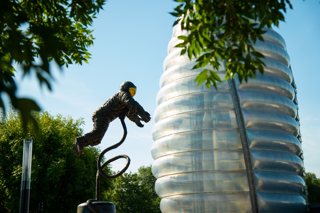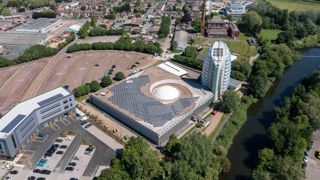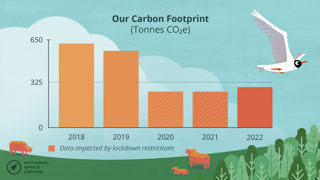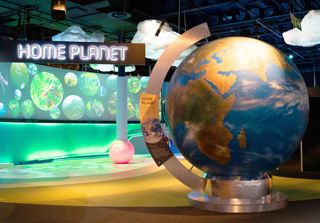
One Smaller Footprint
- 30th Jun 2023
- Author: Elliott Langley - Marketing Administrator
-
![National Space Centre Rocket Tower and astronaut statue]()
National Space Centre Since we opened in 2001, we’ve made it our mission to help people learn about space and to understand our place in the universe better. But what about this place; our ‘home planet’? What are we doing to help keep this blue marble we find ourselves living on happy and healthy? And how can we help other people to do similar?
We have been asking ourselves these types of questions over the last several years, as we reviewed our impact on the environment. Following these discussions, the National Space Centre has made a commitment to being net-zero by 2030.
But what does this actually mean and how are we going to get there?

Net-Zero and Carbon Neutral
It can be easy to lose track of what some of these terms mean, especially at the rate at which new information becomes available and new scientific language is used in the media.
Carbon Neutral simply means that whenever carbon dioxide (CO2) is released into the atmosphere by the activities of an organisation, an equal amount is also removed from the atmosphere. You may have heard of organisations planting trees or investing in agriculture in order to ‘offset’ their carbon emissions; it simply means that companies are balancing out their use of carbon to reduce their impact and keep their carbon output at a ‘neutral’ level.
So how does net-zero differ from this? Being net-zero is when an organisation has reduced the amount of carbon that their operations and activities produce to as low an amount as they possibly can. This is through making changes within the organisation, such as switching to alternative practices that produce less carbon. What remaining carbon is produced is then offset. The National Space Centre has pledged to reduce all carbon emissions to net-zero by 2030 – so how are we going to get there?

The Environmental Working Group
In 2019, we recorded that the National Space Centre produced 621 tonnes of carbon through our standard operations as an organisation. In 2022 we saw that number reduce all the way down to 299 tonnes of CO2. This is a substantial drop; it means that our charity has cut our carbon footprint by over 50% in just 3 years.
This ‘giant leap’ has, in part, been accomplished by changes we have made to our operations that have actively reduced carbon emissions that we directly produce. But before we could do that, we had to figure out exactly how much carbon we produce and what’s creating it.
This is where our Environmental Working Group came in, who were able to break down and categorise our greenhouse gas emissions into 3 ‘scopes’:
- Scope 1: Direct emissions – this is any carbon that is produced on-site, such as gas being pumped into our boilers and then released into the atmosphere. Scope 1 also includes company vehicles.
- Scope 2: Indirect emissions – this is the electricity we purchase to operate the building from energy providers.
- Scope 3: Indict emissions (not owned) – this is effectively any carbon emissions that are produced indirectly by our operations; for example, petrol is used in cars that many of our visitors will use to drive to the Centre. Another example is the waste produced on-site, such as packaging and rubbish.
Having the 3 scopes identified meant that we would now be able to start working on pinpointing where carbon was being produced and where to start making changes.

First Steps
Firstly, we replaced all of our lights with energy efficient LED alternatives throughout the Centre. You may have also noticed signs around the Centre highlighting our solar panels. These were installed on our roof and help to power the exhibition and our office spaces.
Next, we removed the use of gas from our kitchen and science lab spaces. We then switched to an ethically sourced electricity supplier with green credentials.
These actions specifically targeted scope 1 and 2 and resulted in a significant reduction in direct carbon emissions.
Of course, there was another factor at play here that we have to give credit to. Following the outbreak of COVID-19 in 2020, the National Space Centre was forced to close its doors to the public and cease operations for 14 long months. Naturally, this caused carbon emissions to drop significantly in both 2020 and 2021, as the building was closed, and staff remained off-site.
However, upon reopening, we continued to see that number fall. Had we not made significant changes to our infrastructure, we would have seen that number start to rise back to pre-pandemic levels.
-
![Swift Box 2 Scaled]()
What's Next?
Having made steps to tackle our direct emissions, the National Space Centre are looking to further reduce our impact. The Environmental Working Group are looking to work with experts to identify and target the areas that we can have the most impact. Research is also being carried out into alternative systems for heating and cooling, which would help us achieve net zero emissions.
Elsewhere, we are in the process of upgrading our Building Management System, which will make us more efficient in our use of power, cooling and heating throughout the venue.
We are also looking at ways to invest in producing more green renewables and our Chef is looking at a natural composting system for all our compostable service ware and food waste.
A couple of big changes to the visitor experience will see the installation of fresh water bottle refilling stations to stop any single use plastics brought on site by our visitors, as well as installing charging points to help increase the use of electric vehicles.
Of course, there’s still a long way to go in the next 7 years and there will be further challenges and milestones ahead. But the Environmental Working Group and National Space Centre as a whole will continue to make both small steps and giant leaps towards a healthier, happier planet.
“The scientific world agrees that greenhouse gases are damaging our home planet, which makes us responsible for taking care of it. Reducing our carbon footprint is the best way to keep the Earth safe so that future generations can live comfortably on our home planet.”
National Space Centre’s Environmental Working Group


